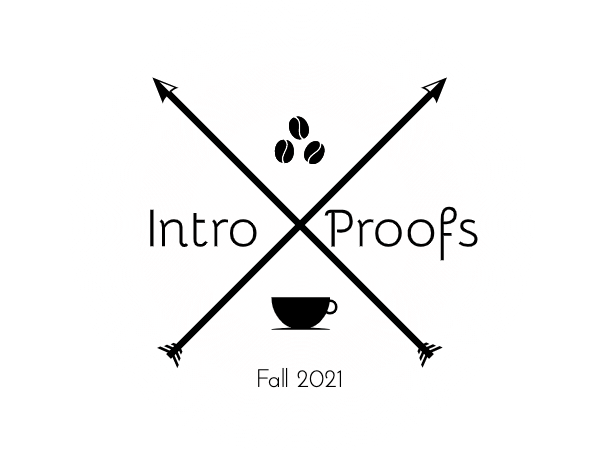Hi everyone! This online lesson is provided as a resource – we will also go over this material in class.

Lesson 2: Cartesian Products and Subsets
Topic. This lesson covers:
- Sec 1.2: Cartesian Products
- Sec 1.3: Subsets
Learning Outcomes.
- Identify and manipulate ordered pairs and Cartesian products of sets.
- Identify and manipulate subsets of sets.
WeBWorK. There is 1 WeBWorK assignment on today’s material:
- Assignment1-Sec1.2-1.3
Lecture Notes:
Contents
Vocabulary
- ordered pair
- Cartesian product
- ordered triple
- Cartesian power
- subset
Cartesian Products
Definitions and Theorems
- An ordered pair is a list $(x,y)$ of two things, $x$ and $y$, enclosed in parentheses and separated by a comma.
- NOTE: unlike a set, the order of the elements is important: $(2,4)$ is NOT the same as $(4,2)$
- The Cartesian product of two sets $A$ and $B$ is another set, written $A \times B,$ and defined as $A \times B=\{(a, b): a \in A, b \in B\}$
- Theorem. If $A$ and $B$ are finite sets, $|A \times B|=|A| \times|B|$.
- An ordered triple is a list $(x,y,z)$.
- A Cartesian power, like $\mathbb{R}^{2},$ is simply shorthand for the product of a set with itself $\mathbb{R}^{2}=\mathbb{R} \times \mathbb{R}$ (similar for higher powers: $N^{3}=N \times N \times N$).
Examples: Cartesian Products
Example 1: If $A=\{p, q, r\}$ and $B=\{w, x\},$ find $A \times B$
Example 2: i) Describe the Cartesian product $\mathbb{R} \times \mathbb{R}$.
ii) If $A$ is the closed interval $[0,1]$ and $B$ is the half-open interval $[2,3),$ draw a sketch of $A \times B$
Example 3: If $A=\{3,7\}, B=\{2,4\},$ and $C=\{5,9\},$ then:
i) is $(3,2,9) \in A \times B \times C$ ?
ii) is $(3,5,2) \in A \times B \times C$ ?
VIDEO: Examples – Cartesian Products
Subsets
Definition. If $A$ and $B$ are sets and every element of $A$ is also an element of $B$, then we say $A$ is a subset of $B$ and we write $A \subseteq B$.
If this is NOT the case then we say $A$ is not a subset of $B,$ and we write $A \nsubseteq B$.
NOTE: $A \subseteq B$ means there is at least one element of A that is not an element of B.
Example 4. If $A=\{2,3,5\}, B=\{2,3,4,5,6,7,8\}$ and $C=\{1,2,3\}$
i) is $A \subseteq B$ ? Why?
ii) is $A \subseteq C$ ? Why?
iii) is $C \subseteq A ?$ Why?
iv) is $A \subseteq A$ ? Why?
v) is $\varnothing \subseteq A$ ? Why?
VIDEO: Example – Subsets
Take a moment to absorb the following two theorems. Do you believe them? Why or why not?
Theorem: Every set is a subset of itself, $A \subseteq A$
Theorem: The empty set is a subset of every set: for any set $A, \varnothing \subseteq A$
Exit Questions
Test your understanding of products and subsets by working through the following examples (selected answers are provided).
- a) If $A=\{\pi, 5\}$ and $B=\{4,7\},$ then
- i) Find $A \times B$ and $B^{2}$
- ii) is $(\pi, 7) \in A \times B ?$
- iii) is $(4,5) \in B \times A ?$ iv) is $(\pi, \pi) \in A^{2} ?$
- b) If $A=\{\{4,5,6\}, \varnothing\}$ and $B=\{N, Z,(\varnothing,\{2,7\})\},$ then
- i) is $(\{4,5,6\}, Z) \in A \times B ?$
- ii) is $(\varnothing, \varnothing) \in A \times B ?$
- iii) Find $A \times B .$ What is $|A \times B| ?$ iv) is $((\varnothing,\{2,7\}), \mathrm{N},\{4,5,6\}) \in B^{3} ?$ What product of $\mathrm{A}$ ‘s and $\mathrm{B}$’s is it an element of?
- c) Sketch each set in the plane.
- i) $[1,2] \times(3,5)$
- ii) $\left(-1,-\frac{1}{2}\right] \times[2,3)$
- ii) $[0,1] \times{1,3,5}$
- d) Consider the set with two elements $\{5,\{5\}\} .$ True or False:
- i) $5 \in\{5,\{5\}\}$
- ii) $5 \subseteq\{5,\{5\}\}$
- iii) $\{5\}\in\{5,\{5\}\}$
- iv) $\{5\}\subseteq\{5,\{5\}\}$
- v) $\{\{5\}\}\in\{5,\{5\}\}$
- vi) {{5}}$\subseteq{5,{5}}$
- e) True or False:
- i) $\{(1,1),(2,6),(5,-1),(3,2)\} \subseteq Z \times Z$
- ii) $\mathrm{N} \times \mathrm{N} \subseteq \mathrm{R} \times \mathrm{R}$
Selected Answers
a.ii) Yes
a.iv) Yes
b.i) Yes
b.ii) No (Why not?)
c.i)

d.ii) False (there must be a SET on both sides of a $\subseteq$ sign, and 5 is not a set)
d.vi) False
e.i) True (why?)





0 Comments
1 Pingback